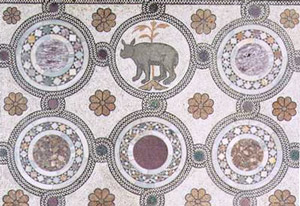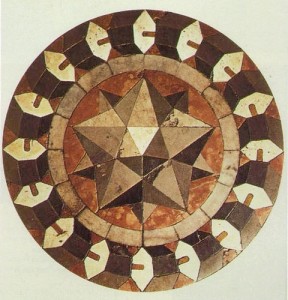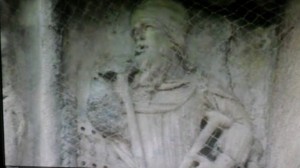Still in the 982 was called free from servitute to Sanctae Matris Ecclesiae ( “free from the bondage of Holy Mother Church ” )
At the same time , mausoleum and chapel of the Doge , and therefore with both religious and political function , the sanctuary of St. Mark, as well as the nearby church of his predecessor, Theodore, was demolished ( in 1063 ) to make way for the third and last building , the current basilica.
The new church was consecrated in 1094 , the legend said that in the same year was “miraculously discovered” in a pillar of the basilica, the body of San Marco, which has been hidden during the work , and forgotten there. ( the altar of Sacrament )
The architectural form is very close to that of the ancient Basilica of the Holy Apostles in Constantinople ( Greek cross ,surmounted by five domes ; the church was destroyed after the Ottoman conquest ) .
In the hall , the floor plane remain at the level of the square while inside the basilica is
 raised up a few steps to create a sort of ascending path , carefully calculated to gradually prepare the visitor for recollection that from the noisy and distracting open space of the square, is about to enter in the temple.
raised up a few steps to create a sort of ascending path , carefully calculated to gradually prepare the visitor for recollection that from the noisy and distracting open space of the square, is about to enter in the temple.
To not to be stolen by the soldiers of Napoleon “the golden ball ” (palla d’oro) was hidden by a courageous Venetian citizen who holds that hidden in his house many months ;and so the only example of Gothic jewelery remained whole and save.
 A stellated dodecahedron is located on the first floor of the main door entrance to the Basilica , under the iconostasis and the choir. For the sages of antiquity , it was the symbol of Venus, the planet ruler of Venice. Represents the event of the Divine in Nature . On the left side of the entrance of the Basilica, on the mosaic floor , there is a rhinoceros of uncertain date , symbol of strength .This would also be a talisman to ward off diseases.
A stellated dodecahedron is located on the first floor of the main door entrance to the Basilica , under the iconostasis and the choir. For the sages of antiquity , it was the symbol of Venus, the planet ruler of Venice. Represents the event of the Divine in Nature . On the left side of the entrance of the Basilica, on the mosaic floor , there is a rhinoceros of uncertain date , symbol of strength .This would also be a talisman to ward off diseases.
In the central part of the basilica, under the dome , is placed a large square from blue marble once called “The sea” for the depressions that were there , due to the continuous settling of the ground .
On the ground, near the Pala d’Oro , there is a stone depicting a ducal horn and an animal, a black hedgehog. Here was buried the heart of the Doge Francesco Erizzo (1566-1646 , doge from 1631 ) . The hedgehog is a symbol of noble family membership . The rest of the remains are buried in the church of St. Martin (Castello).
Baptistery
this chapel , also called the Church of Putti , there is also the tomb of the Doge Andrea Dandolo . The altar is made by a large granite boulder from Tyre, which tradition says was the one from which Christ spoke to the crowds .
Chapel of St. Isidore
located on the bottom of the left side of the basilica. The partition wall covered in marble that separates it from the basilica corresponds to the original outer wall of the ancient church of San Teodoro ( the saint patron of the ancient Venice) .
The Zen Chapel , or the “Madonna della Scarpa”(of the shoe) was built by “order of the Signoria” in 1501 , when,the Cardinal Giambattista Zen died. In the middle of the altar is a statue of the ” Virgin and Cherub ” by Antonio Lombardo. The figure of the virgin keep in hand a golden shoe to commemorate the legend of the shoe offered as a gift to Mary from a poor faithful, who was miraculously transformed into gold.
 Among the basorilievi of the arches above the entrance there appears an old man who bites his hand: it is the architect of the basilica and the legend said ,that he was relieved of his duties when he said that he would be able to build it even more beautiful .
Among the basorilievi of the arches above the entrance there appears an old man who bites his hand: it is the architect of the basilica and the legend said ,that he was relieved of his duties when he said that he would be able to build it even more beautiful .
 The famous bronze horses were at the beginning gilded of gold and silver , and were brought by the Venetians during the Fourth Crusade from the Hippodrome of Constantinople ;now they are kept in the museum inside the Basilica of San Marco . Outside are copies of the original.
The famous bronze horses were at the beginning gilded of gold and silver , and were brought by the Venetians during the Fourth Crusade from the Hippodrome of Constantinople ;now they are kept in the museum inside the Basilica of San Marco . Outside are copies of the original.
The three pillars-bearer in front of the basilica once beared the flags of the territories of Candia, Cyprus and Morea conquered from Venice.
The two columns coming from the east, in the entrance to the square, in honour of the first saint patron of Venice,Saint Theodor, and the actual patron saint Mark, (which has become such after the legendary theft of the body) originally, were three, but one of them sank during the transfer from Constantinople and can’t be recovered.
see also:http://dipoco.altervista.org/basilica-san-marco/
other items http://dipoco.altervista.org/
visit my website http://ginocosta.altervista.org/